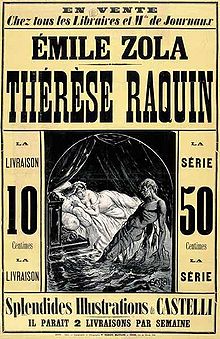Thérèse Raquin
| Thérèse Raquin | |
|---|---|
 |
|
| Written by | Émile Zola |
| Date premiered | 1867 / 1873 |
| Original language | French |
| Genre | Literary Naturalism, Theatrical Naturalism, Psychological novel |
Thérèse Raquin [teʁɛz ʁakɛ̃] is a novel (first published in 1867) and a play (first performed in 1873) by the French writer Émile Zola. The novel was originally published in serial format in the journal L'Artiste and in book format in December of the same year.
Thérèse Raquin tells the story of a young woman, unhappily married to her first cousin by an overbearing aunt who may seem to be well-intentioned but in many ways is deeply selfish. Thérèse's husband, Camille, is sickly and egocentric, and when the opportunity arises, Thérèse enters into a turbulent and sordidly passionate affair with one of Camille's friends, Laurent.
In his preface, Zola explains that his goal in this novel was to "study temperaments and not characters". Because of this detached and scientific approach, Thérèse Raquin is considered an example of naturalism.
Thérèse Raquin is the daughter of a French sea-captain and an Algerian mother. After the death of her mother, her father brings her to live with her aunt, Madame Raquin, and her valetudinarian son, Camille. Because her son is "so ill", Madame Raquin dotes on Camille to the point where he is selfish and spoiled. Camille and Thérèse grow up side-by-side, and Madame Raquin marries them to one another when Thérèse is 21. Shortly thereafter, Camille decides that the family should move to Paris so he can pursue a career.
Thérèse and Madame Raquin set up shop in the Passage du Pont Neuf to support Camille while he searches for a job. Camille eventually begins working for the Orléans Railway Company, where he meets up with a childhood friend, Laurent. Laurent visits the Raquins and decides to take up an affair with the lonely Thérèse, mostly because he cannot afford prostitutes any more. However, this soon turns into a torrid love affair.
They meet regularly and secretly in Thérèse's room. After some time, Laurent's boss no longer allows him to leave early, and so the two lovers have to think of something new. Thérèse comes up with the idea of killing Camille. They eventually drown him during a boat trip, though in defending himself Camille succeeds in biting Laurent on the neck. Madame Raquin is in shock after hearing the disappearance of her son and everybody believes that the drowning was an accident and that the couple actually attempted to save Camille. Laurent is still uncertain about whether Camille is truly dead and frequently visits the mortuary, where he finally finds the dead Camille. Thérèse has nightmares and is very subdued, so Michaud—one of the regular visitors of the family—comes up with the idea that Thérèse should marry again and that the ideal husband would be Laurent. They marry but they are haunted by the memory of the murder they have committed. They have hallucinations of the dead Camille in their bedroom every night, preventing them from touching each other and quickly driving them insane. Laurent, who is an artist, can no longer paint a picture (even a landscape) which does not in some way resemble the dead man. They also have to look after Madame Raquin, who has suffered a stroke after Camille's death. Madame Raquin suffers a second stroke and becomes completely paralyzed (except for her eyes), after which Thérèse and Laurent reveal the murder in her presence during an argument.
...
Wikipedia
